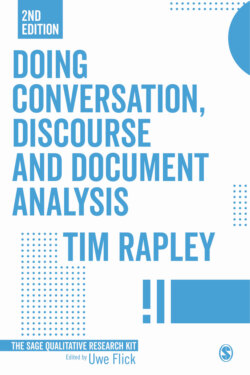Читать книгу Doing Conversation, Discourse and Document Analysis - Tim Rapley - Страница 20
На сайте Литреса книга снята с продажи.
Some closing comments on working with documents
ОглавлениеIn general, you work with a range of documents, covering both:
primary sources: historically contemporary and/or first-hand accounts; and
secondary sources: historically or spatially distant and/or second-hand accounts.
For example, I became interested in why, when we visit the theatre, we all sit very quietly, become relatively immobile and condemn others (and sometimes feel anger towards others) for breaching these rules. I went to various archives and generated a collection of materials around the audience in London’s theatres. I learned that it is only in the recent past, over a period between the nineteenth and twentieth centuries, especially around the 1880s, that theatre-goers became increasingly ‘tamed’. Prior to this, audiences did things like shout at actors to repeat what they felt were well-delivered monologues, talked to their friends who had purchased the more expensive seats that were placed on stage, or threw food at actors whom they felt were ‘bad’. The shift from the more carnivalesque occurrences of past audiences to today’s docile assembly was mediated by various trajectories, including:
the growth of a new middle class (with new ‘polite’ values and norms);
the introduction of gas stage lighting (with the audience now sitting in darkness); and
the entrepreneurship of certain theatre owners (with the building and refurbishment of theatres to cater for the new, refined, middle classes).
This research was made possible by using secondary sources – more ‘academic’ books and articles on the history of theatrical performance, design, production and ownership – and primary sources, such as nineteenth-century critics’ commentaries on certain productions and audience behaviour, actors and audience members’ diaries and letters, newspaper articles, debates in Parliament and theatrical trade publications.
Often the best starting point is to read other academic work on the specific topic and to find out what documents they used and where they found them. These secondary sources will generally provide commentaries on and copies of (parts of) the original documents and may contain the details of the specific places they sourced the original documents from. Generally, you will want to focus your analysis on these or other original documents, on primary sources, rather than just relying on these secondary accounts.
Even if your research is not primarily focused on how the press, academics, individuals or organizations render knowledge about your specific topic, or you are not really interested in tracing the history and development of ideas, practices or institutions that we take for granted today, documents about that topic can help you engage with and re-think the research. They are vital resources for any form of research, be it as part of the stages or practices called ‘literature reviews’, ‘background reading’ or ‘producing questions for focus groups’ or as ways to spark new (and old, long forgotten) thoughts about your research. As such, being aware of and engaged with text-based documents is essential to all research practice. The other key source in contemporary research practice is audio- and visual-based sources. It is to these that we now turn.
